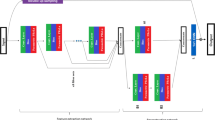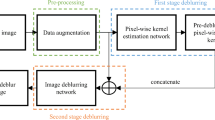Abstract
Digital images could be degraded by a variety of blur during the image acquisition (i.e. relative motion of cameras, electronic noise, capturing defocus, and so on). Blurring images can be computationally modeled as the result of a convolution process with the corresponding blur kernel and thus, image deblurring can be regarded as a deconvolution operation. In this paper, we explore to deblur images by approximating blind deconvolutions using a deep neural network. Different deep neural network structures are investigated to evaluate their deblurring capabilities, which contributes to the optimal design of a network architecture. It is found that shallow and narrow networks are not capable of handling complex motion blur. We thus, present a deep network with 20 layers to cope with text image blur. In addition, a novel network structure with Sequential Highway Connections (SHC) is leveraged to gain superior convergence. The experiment results demonstrate the state-of-the-art performance of the proposed framework with the higher visual quality of the delurred images.








Similar content being viewed by others
References
Abadi M, Agarwal A, Barham P, Brevdo E, Chen Z, Citro C, Corrado GS, Davis A, Dean J, Devin M, Ghemawat S, Goodfellow I, Harp A, Irving G, Isard M, Jia Y, Jozefowicz R, Kaiser L, Kudlur M, Levenberg J, Mané D, Monga R, Moore S, Murray D, Olah C, Schuster M, Shlens J, Steiner B, Sutskever I, Talwar K, Tucker P, Vanhoucke V, Vasudevan V, Viégas F, Vinyals O, Warden P, Wattenberg M, Wicke M, Yu Y, Zheng X (2015) TensorFlow: Large-scale machine learning on heterogeneous systems. http://tensorflow.org/. Software available from tensorflow.org
Anat L, Yair W, Fredo D, William TF (2009) Understanding and evaluating blind deconvolution algorithms. In: International conference on computer vision and pattern recogintion (CVPR)
Boracchi G, Foi A (2011) Uniform motion blur in poissonian noise: blur/noise trade-off. In: IEEE transactions on image processing (TIP)
Boracchi G, Foi A (2012) Modeling the performance of image restoration from motion blur. In: IEEE transactions on image processing (TIP)
Chakrabarti A (2016) A neural approach to blind motion deblurring. In: Europeon conference on computer vision (ECCV), pp 221–235
Dilip K, Rob F (2009) Fast image deconvolution using hyper-laplacian priors. In: Conference and workshop on neural information processing systems (NIPS)
Dilip K, Terence T, Rob F (2011) Blind deconvolution using a normalized sparsity measure. In: International conference on computer vision and pattern recogintion (CVPR)
Gong D, Yang J, Liu L, Zhang Y, Reid ID, Shen C, van den Hengel A, Shi Q (2017) From motion blur to motion flow: a deep learning solution for removing heterogeneous motion blur. In: International conference on computer vision and pattern recogintion (CVPR), pp 3806–3815
Isola P, Zhu J, Zhou T, Efros AA (2017) Image-to-image translation with conditional adversarial networks. In: International conference on computer vision and pattern recogintion (CVPR), pp 5967–5976
Jian S, Wenfei C, Zongben X, Jean P (2015) Learning a convolutional neural network for non-uniform motion blur removal. In: International conference on computer vision and pattern recogintion (CVPR)
Jinshan P, Zhe H, Zhixun S, Ming-Hsuan Y (2014) Deblurring text images via l0-regularized intensity and gradient prior. In: International conference on computer vision and pattern recogintion (CVPR)
Kaiming H, Xiangyu Z, Shaoqing R, Jian S (2016) Deep residual learning for image recognition. In: International conference on computer vision and pattern recogintion (CVPR)
Kupyn O, Budzan V, Mykhailych M, Mishkin D, Matas J (2017) Deblurgan: blind motion deblurring using conditional adversarial networks. arXiv:1711.07064
Lee C, Xie S, Gallagher PW, Zhang Z, Tu Z (2015) Deeply-supervised nets. In: Proceedings of the Eighteenth International Conference on Artificial Intelligence and Statistics, AISTATS 2015, San Diego, California, USA, May 9-12, 2015
Li X, Jiaya J (2010) Two-phase kernel estimation for robust motion deblurring. In: Europeon conference on computer vision (ECCV)
Li X, SJ RJ, Ce L, Jiaya J (2014) Deep convolutional neural network for image deconvolution. In: Conference and workshop on neural information processing systems (NIPS)
Michal H, Jan K, Pavel Z, Filip Š (2015) Convolutional neural networks for direct text deblurring. In: British machine vision conference (BMVC)
Nah S, Kim TH, Lee KM (2017) Deep multi-scale convolutional neural network for dynamic scene deblurring. In: International conference on computer vision and pattern recogintion (CVPR), pp 257–265
Nie L, Wang M, Zha Z, Chua T (2012) Oracle in image search: A content-based approach to performance prediction. ACM Trans Inf Syst 30(2):13:1–13:23
Nie L, Wang X, Zhang J, He X, Zhang H, Hong R, Tian Q (2017) Enhancing micro-video understanding by harnessing external sounds. In: Proceedings of the 2017 ACM on multimedia conference, MM 2017, Mountain View, CA, USA, October 23-27, 2017, pp 1192–1200
Nie L, Yan S, Wang M, Hong R, Chua T (2012) Harvesting visual concepts for image search with complex queries. In: Proceedings of the 20th ACM multimedia conference, MM ’12, Nara, Japan, October 29 - November 02, 2012, pp 59–68
Noroozi M, Chandramouli P, Favaro P (2017) Motion deblurring in the wild. In: Pattern recognition - 39th german conference (GCPR), pp 65–77
Qi S, Jiaya J, Aseem A (2008) High-quality motion deblurring from a single image. In: ACM transactions on graphics (TOG)
Ramakrishnan S, Pachori S, Gangopadhyay A, Raman S (2017) Deep generative filter for motion deblurring. In: International conference on computer vision (ICCV), pp 2993–3000
Rob F, Barun S, Aaron H, Sam TR, William TF (2006) Removing camera shake from a single photograph. In: ACM Transactions on graphics (TOG)
Ruomei Y, Ling S (2013) Image blur classification and parameter identification using two-stage deep belief networks. In: British machine vision conference (BMVC)
Sergey I, Christian S (2015) Batch normalization: accelerating deep network training by reducing internal covariate shift. arXiv:1502.03167
Yangqing J, Evan S, Jeff D, Sergey K, Jonathan L, Ross G, Sergio G, Trevor D (2014) Caffe: convolutional architecture for fast feature embedding. arXiv:1408.5093
Author information
Authors and Affiliations
Corresponding author
Additional information
Publisher’s note
Springer Nature remains neutral with regard to jurisdictional claims in published maps and institutional affiliations.
Rights and permissions
About this article
Cite this article
Mei, J., Wu, Z., Chen, X. et al. DeepDeblur: text image recovery from blur to sharp. Multimed Tools Appl 78, 18869–18885 (2019). https://doi.org/10.1007/s11042-019-7251-y
Received:
Revised:
Accepted:
Published:
Issue Date:
DOI: https://doi.org/10.1007/s11042-019-7251-y




